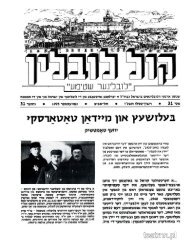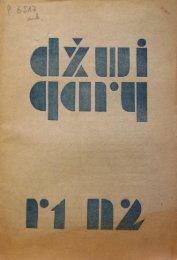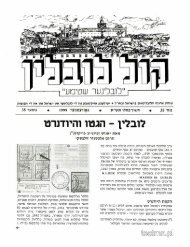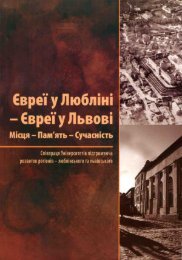The Jews in Lublin - Biblioteka Multimedialna Teatrnn.pl - Brama ...
The Jews in Lublin - Biblioteka Multimedialna Teatrnn.pl - Brama ...
The Jews in Lublin - Biblioteka Multimedialna Teatrnn.pl - Brama ...
You also want an ePaper? Increase the reach of your titles
YUMPU automatically turns print PDFs into web optimized ePapers that Google loves.
concerns the presence of the <strong>Jews</strong> and their culture <strong>in</strong> the everyday life of both cities<br />
("<strong>The</strong> Present").<br />
1. Places<br />
<strong>The</strong> article written by Adam Kopciowski concerns the history of the <strong>Jews</strong> <strong>in</strong> Lubl<strong>in</strong>.<br />
<strong>The</strong> author presents their history beg<strong>in</strong>n<strong>in</strong>g with the First Republic, through the 19th<br />
Century and the <strong>in</strong>terwar period, the tragic experiences of the Holocaust dur<strong>in</strong>g the<br />
Second World War, reach<strong>in</strong>g the difficult post-war years. <strong>The</strong> author consistently proves<br />
that the Jewish community constituted an <strong>in</strong>tegral part of the city, creat<strong>in</strong>g its exceptional<br />
image <strong>in</strong> each of the function<strong>in</strong>g aspects. In this view, Lubl<strong>in</strong> is a Polish-Jewish<br />
city, open also to other nations and traditions, <strong>in</strong> which the multi-cultural structure of<br />
the old Jagiellonian country was focused. (Outl<strong>in</strong>e History of the <strong>Jews</strong> <strong>in</strong> Lubl<strong>in</strong>).<br />
This city rema<strong>in</strong>s <strong>in</strong> the memory of many <strong>Jews</strong> <strong>in</strong> the world as the capital of Chassidism,<br />
and this is expressed <strong>in</strong> the next two articles. Agata Paluch presents the most<br />
important issues concern<strong>in</strong>g the <strong>in</strong>heritance of the great masters who lived here <strong>in</strong><br />
previous centuries, (Mystical Traditions <strong>in</strong> the Teach<strong>in</strong>gs of the Rabbis of Lubl<strong>in</strong>), and<br />
Ewa Grochowska recalls the most important tendencies <strong>in</strong> Early-Chassidic mysticism<br />
(<strong>in</strong> contemporary studies called the "mystical heresy"), connected to the Lubl<strong>in</strong> region<br />
and such figures as Sabbataj Cwi and Jakub Frank (Messianic Movements <strong>in</strong> the Lubl<strong>in</strong><br />
Region <strong>in</strong> the 17th and 18th Century). Part of the historic considerations of this subject<br />
is com<strong>pl</strong>eted (and simultaneously opens the Lviv subject matter) with the article written<br />
by Konrad Zieliński. This tells about the experiences of <strong>Jews</strong> on the route to assimilation<br />
<strong>in</strong> two different Polish Partitions - the Austrian and the Russian Partitions,<br />
(<strong>The</strong> Routes to Emancipation for the Galician and the Congress K<strong>in</strong>gdom <strong>Jews</strong>).<br />
Next two articles concern the Jewish community of Lviv. Anna Kraczkowska creates<br />
a view of their colonization <strong>in</strong> the city, show<strong>in</strong>g also the centuries-old conflict<br />
between <strong>Jews</strong> and non-<strong>Jews</strong> {Jewish Community of Lviv between 16th and 18th Century<br />
— areas of colonization and legal status). Mikola Hetmanczuk presents the experiences<br />
of <strong>Jews</strong> from the most difficult Soviet times, debunk<strong>in</strong>g the myths about the omnipresence<br />
of <strong>Jews</strong> <strong>in</strong> the Soviet safety apparatus. <strong>Jews</strong> were <strong>in</strong> many cases the victims<br />
of this system, exactly the same as the Poles, the Ukra<strong>in</strong>ians or the Armenians. (<strong>The</strong><br />
Participation of the Jewish Population <strong>in</strong> the Process of the Formation of the Intelligentsia<br />
<strong>in</strong> the Lviv Region <strong>in</strong> the Post-War Period (1944-1953).<br />
2. Memory<br />
This part beg<strong>in</strong>s with texts concern<strong>in</strong>g the cultural heritage of the <strong>Jews</strong> and the<br />
manner of its commemoration <strong>in</strong> Poland and Ukra<strong>in</strong>e, from the perspective of the<br />
past and the present. <strong>The</strong>y cover the religious museums established at the turn of the<br />
19th and 20th Centuries (not only Judaic), which preserved already unused objects<br />
of culture for posterity (Beata Skrzydlewska, Jewish and Christian Religious Museums),<br />
8

















